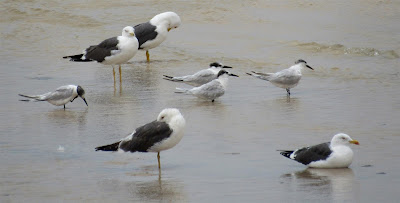mostly lesser black-backed gull (courtesy of Mohamed Vall)
The lesser black-backed gull were still there in large numbers. However there were notably less Mediterranean gull and Audouin gull. A few more terns had arrived too as spring advances.
sandwich tern with lesser black backed gull
Most of the new terns were either sandwich tern or more Caspian tern which have swelled the winter numbers of the latter.
Caspian tern diving (courtesy of Mohamed Vall)
The big change has not yet happened. I am keen to find out what the summer diversity there is on the coast. Is it too much to ask for the odd roseate tern and bridled tern to add to my country list.
Elsewhere we looked closely at many of the crested lark once again for any thekla lark which have been ocassionally reported but which I am a little cynical.
young crested lark
We did find a very short billed lark which is one of the realtive characteristics of thekla lark compared to crested lark. Unfortunately the bird was clearly very young. It had a yellow gape and many feathers were fringed pale buff.
The fisherman's rubbish dump did not yield the hoped-for red-throated pipit though yellow wagtail numbers were up and two white wagtail are lingering.
After the fishing port, we headed south to the water company site in the Riyadh district. The factory produces a small river which lasts 50 metres.
African silverbill and red-billed quelea
We were hampered in our observations by easterly winds bringing a dust storm off the Sahara. This was the closest to Nouakchott that I had seen red-billed quelea. African silverbill are also present in lesser numbers. The two sometimes form mixed flocks though the red-billed quelea numbers are so much larger.
white wagtail
Once again my main target was red-throated pipit though there were other possibilities since the main passage season has just begun.
The pipit's cousins were present. These were namely white wagtail and yellow wagtail.
yellow wagtail
A pipit was briefly seen. However I am confident it was a tree pipit. In spring they are easily separated. In autumn it is more difficult as the red throat and face have usually gone.
sudanese golden sparrow
House sparrow and a few sudanese golden sparrow added to the density of birds at the site. I considered a petronia for the sparrow above but couldn't make it fit!
greater short toed lark (courtesy of Mohamed Vall)
The rarest bird, at least in the Nouakchott area was greater short toed lark. Indeed two of them kept returning to the water bank to drink.
It always pays to stay alert when birding. Plenty of female black-crowned sparrow lark came to drink too and these two short toed lark could easily have been over-looked.
greater short toed lark (courtesy of Mohamed Vall)
Our last call was to North Noaukchott Lake. Sadly the trash had continued to gather but the birds have not yet vacated.
speckled pigeon
This place must be visited regularly. It always produces at least 30 species. However the mix has not changed radically for spring yet. The ducks have gone but small numbers of the black-headed gull, Mediterranean gull and black-backed gull remain.
yellow wagtail
Yet another look for red-throated pipit proved fruitless. Once again both yellow wagtail and white wagtail were present. The pipit is becoming a nemesis bird for me in Mauritania.
common snipe
Wader numbers are peaking though once again no new species have been seen.
40 barn swallow (courtesy of Mohamed Vall)
There was a big influx of barn swallow that day. We counted 65 which prompted E-bird to describe it as a rare occurance and required an explanation.
closer view of some barn swallow
I am pretty much confined to Nouakchott for a while. I hope the city can provide a good mix this spring.
This weekend, at least the variety and numbers of terns has improved the mix. I will blog about that next.
















No comments:
Post a Comment